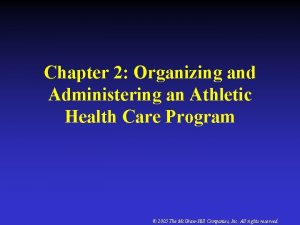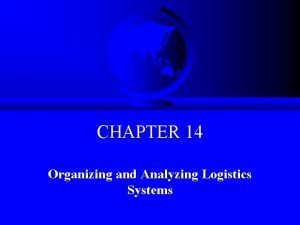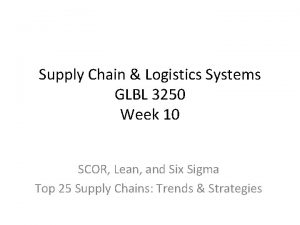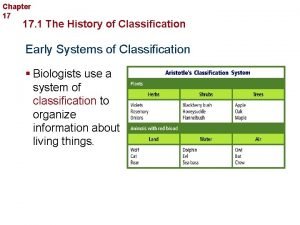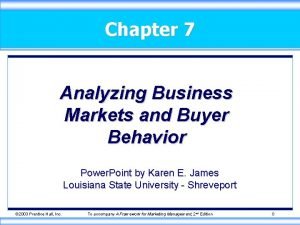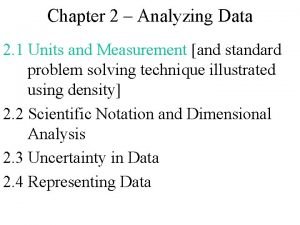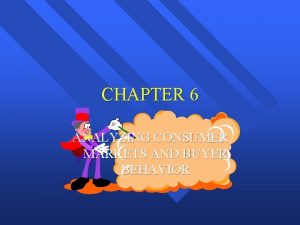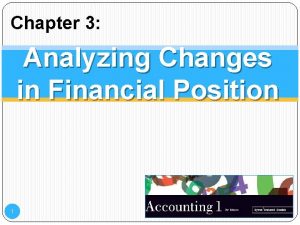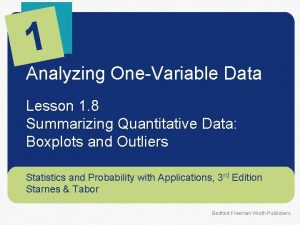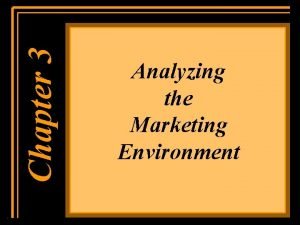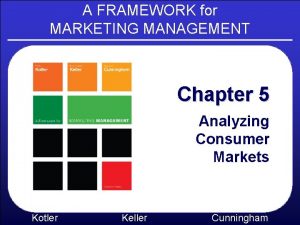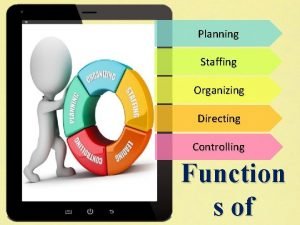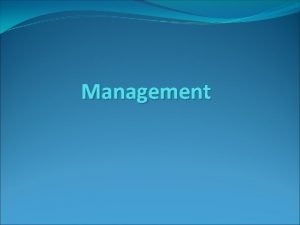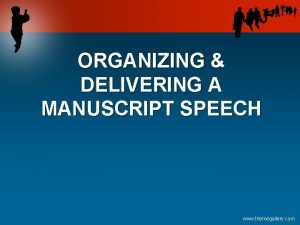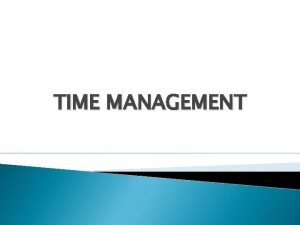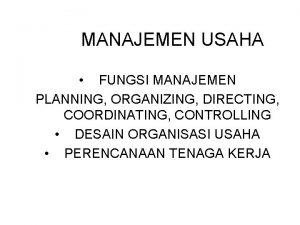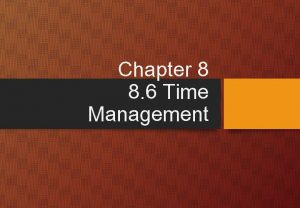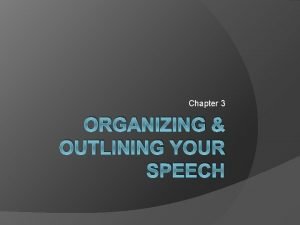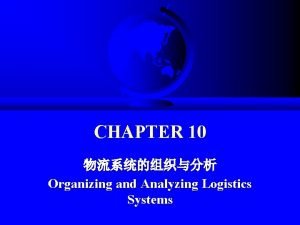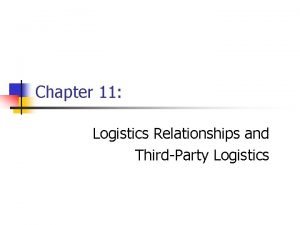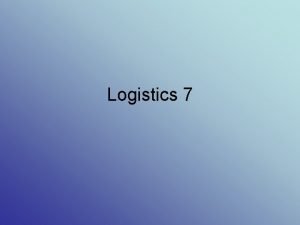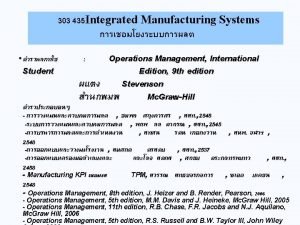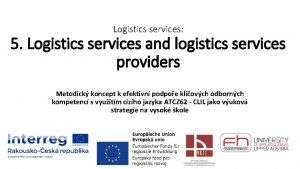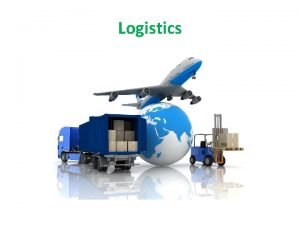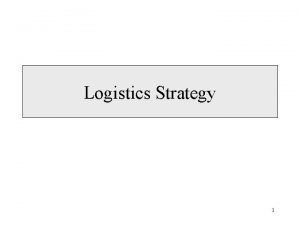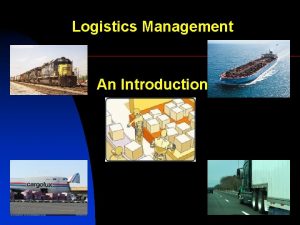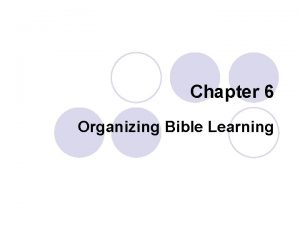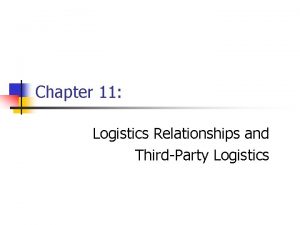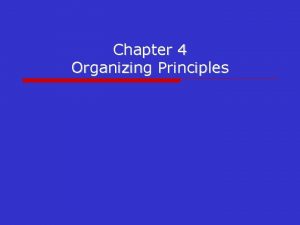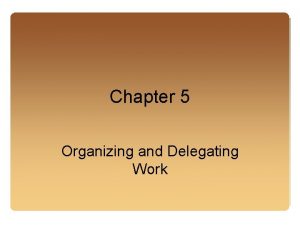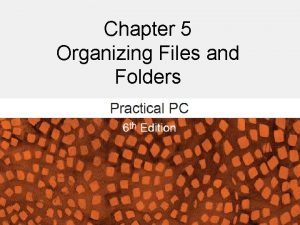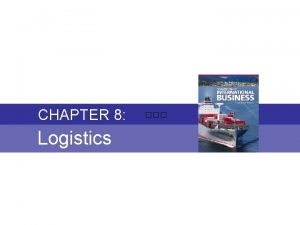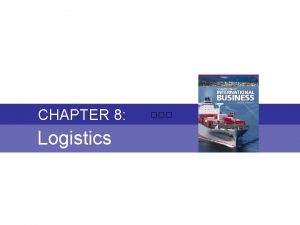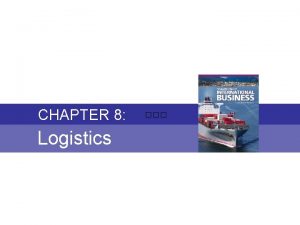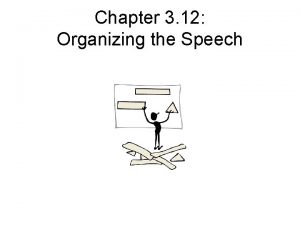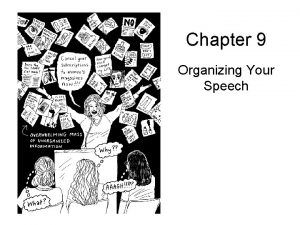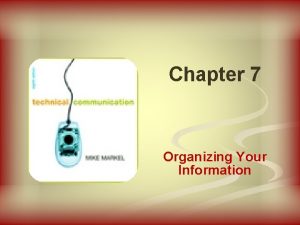Chapter 14 Organizing and Analyzing Logistics Systems Learning




































- Slides: 36

Chapter 14 Organizing and Analyzing Logistics Systems

Learning Objectives • To examine organizational structure for logistics • To learn about traditional and contemporary organizational design for logistics • To explore productivity issues in logistics • To learn about ways to manage theft and pilferage • To introduce you to the concept of logistics social responsibility • To discuss issues associated with reverse logistics • To expose you to programs designed to lessen the impact of terrorism on logistics systems © Pearson Education, Inc. publishing as Prentice Hall 4 -2

Organizational and Managerial Issues in Logistics Key Terms • “C-level” position • Centralized logistics organization • Container Security Initiative (CSI) • Customs Trade Partnership Against Terrorism (C-TPAT) • Decentralized logistics organization • Excess capacity • Flexibility • Fragmented logistics structure • Importer Security Filing (ISF) rule © Pearson Education, Inc. publishing as Prentice Hall 4 -3

Organizational and Managerial Issues in Logistics Key Terms • Logistics social responsibility • Pilferage • Productivity • Relevancy • Responsiveness • Reverse logistics • Tachograph • Theft • Transportation Worker Identification Credential (TWIC) • Unified logistics structure © Pearson Education, Inc. publishing as Prentice Hall 4 -4

Organizing Logistics within the Firm • Two key organizational logistics topics – Organizational structure – Organizational design © Pearson Education, Inc. publishing as Prentice Hall 4 -6

Organizational Structure for Logistics • Two basic organizational structures are: – Fragmented logistics structure • Logistics activities are managed in multiple departments throughout an organization – Unified logistics structure • Multiple logistics activities are combined into and managed as a single department © Pearson Education, Inc. publishing as Prentice Hall 4 -7

Organizational Structure for Logistics • Two basic organizational structures for logistics departments are: – Centralized logistics organization • Company maintains a single logistics department that administers the related activities for the entire company from the home office – Decentralized logistics organization • Logistics-related decisions are made separately at the divisional or product group level and often in different geographic regions © Pearson Education, Inc. publishing as Prentice Hall 4 -8

Figure 14 -1: Becton Dickinson’s Worldwide Sources © Pearson Education, Inc. publishing as Prentice Hall 4 -8

Organizational Structure for Logistics • Job title or corporate rank – Leading edge organizations tend to head the logistics department by senior-level personnel – Generally excluded from holding a “C-level” position © Pearson Education, Inc. publishing as Prentice Hall 4 -10

Organizational Design for Logistics • Three primary types of organizational design include: – Hierarchical (functional) • Top-down flow – Matrix • Cross-functional responsibilities – Network • Process philosophy focused on combing tasks into value-creating products and activities © Pearson Education, Inc. publishing as Prentice Hall 4 -10

Organizational Design for Logistics • Network organizational design is exhibited in terms of: – Relevancy – Responsiveness – Flexibility © Pearson Education, Inc. publishing as Prentice Hall 4 -11

Managerial Issues in Logistics • Productivity – can be defined as the amount of output divided by the amount of input. – Provides insight into the efficiency with which corporate resources are being utilized. • Three ways to improve productivity – Reduce the amount of input while holding output constant – Increase the amount of output while holding input constant Pearson decreasing Education, Inc. – Increase output©while input publishing as Prentice Hall 4 -12

Worker Productivity • Warehousing and transportation are heavily dependent on human labor • Human labor is an input • Logistics-operating employees are unionized in some areas • Warehousing facilities have specific work rules • Warehouse employees can be monitored by direct supervision • Transportation employees (truck drivers) can be monitored through technology, i. e. tachograph © Pearson Education, Inc. publishing as Prentice Hall 4 -13

Asset Productivity • Asset-related productivity concerns include: – Space utilization • Excess capacity – Improving the output from existing assets © Pearson Education, Inc. publishing as Prentice Hall 4 -14

Theft and Pilferage • Thoughts regarding theft – Insurance companies may reimburse for loss, but time and costs tend not to be covered – Theft results in the planned flow of goods being interrupted which can lead to stockouts – Theft can factor into facility location decisions © Pearson Education, Inc. publishing as Prentice Hall 4 -15

Theft and Pilferage • Thoughts regarding pilferage – Transportation and warehousing operations are particularly vulnerable to pilferage – Managing pilferage begins with the hiring process – Zero tolerance pilferage policy – Keep goods moving through the system – Recent increase in pirate attacks © Pearson Education, Inc. publishing as Prentice Hall 4 -16

Lessening the Impact of Terrorism on Logistics Systems • Terrorism can be defined as “the unlawful use or threatened use of force or violence by a person or an organized group against people or property with the intention of intimidating or coercing societies or government, orfter for idological or polictical reasons. ” Source: Terrorism, The American Heritage® Dictionary of the English Language, 4 th ed. (n. d. ). Retrieved from Dictionary. com website: http: //dictionary. reference. com/browse/terrorism. © Pearson Education, Inc. publishing as Prentice Hall 4 -17

Lessening the Impact of Terrorism on Logistics Systems • September 11 terrorist attacks have impacted logistics practices on a worldwide basis • Greater attention given to: – Processes – Procedures – Activities © Pearson Education, Inc. publishing as Prentice Hall 4 -18

Lessening the Impact of Terrorism on Logistics Systems • Creation of the Department of Homeland Security (DHS) – Federal agency – Goals are • To prevent terrorist attacks in the U. S. • To reduce the vulnerability of the U. S. to terrorism © Pearson Education, Inc. publishing as Prentice Hall 4 -19

Lessening the Impact of Terrorism on Logistics Systems • 22 separate government entities were incorporated into DHS – Transportation Security Administration (TSA) • Transportation Worker Identification Credential (TWIC) – Customs and Border Protection (CBP) • Container Security Initiative (CSI) • Customs Trade Partnership Against Terrorism (CTPAT) • Importer Security Filing (ISF) rule © Pearson Education, Inc. publishing as Prentice Hall 4 -20

Timeline for Presenting Electronic Advance Manifest Information © Pearson Education, Inc. publishing as Prentice Hall 4 -21

Information Required for 10+2 Rule © Pearson Education, Inc. publishing as Prentice Hall 4 -22

What Is Systems Analysis? • Systems analysis refers to the orderly and planned observation of one or more segments in the logistics network or supply chain to determine how well each segment functions © 2008 Prentice Hall 14 -23

General Questions • • Why do we perform each task? What value is added by it? Why are the tasks performed in the order they are? Can we alter the sequence of the processing steps to increase efficiency? • Why are the tasks performed by a particular group or individual? • Could others perform this task? • Is there a better way for the system to operate? © 2008 Prentice Hall 14 -24

Problems in Systems Analysis • Multiple business functions are impacted • There are trade-offs among conflicting objectives • Logistics system impacts are difficult to precisely evaluate • There are business issues unique to each logistics system • Quantitative analysis is essential for intelligent decisions © 2008 Prentice Hall 14 -25

Figure 14 -2: A Scoring Checklist Used to Determine Logistics Planning or Strategy Study © 2008 Prentice Hall 14 -26

Partial Systems Analysis • • Customer profitability analysis Warehousing productivity analysis Transportation cost analysis Consolidation analysis Direct product profitability analysis Benchmarking Industry standards analysis © 2008 Prentice Hall 14 -27

Logistics System Design • • • Establishing objectives and constraints Quality programs World-class logistics programs System constraints Organization of the study team Data collection © 2008 Prentice Hall 14 -28

Logistics System Design (continued) • • Product audit Existing facilities audit Vendor audit Customer audit Channels audit Competition audit Environmental sensitivity audit © 2008 Prentice Hall 14 -29

Figure 14 -4: Flexibility Makes It Easier to Work Together © 2008 Prentice Hall 14 -30

Logistics System Design (continued) • Analysis of the data • Simulation • Design implementation © 2008 Prentice Hall 14 -31

Case 14 -2 Trigo Export Co. , Ltd. Company Facts: • Located in Montreal, Canada • Manufacturer’s export agent for the Ziola Tractor Co. of Winnipeg Issues: • Bidding 40~100 units of garden tractors 1 -32

Case 14 -2 Trigo Export Co. , Ltd. Facts: 1. No import duties, permits, or licenses are required 2. Documentation cost would be CAN$250 per shipment 3. Ziola would sell to Trigo any quantity of tractors (up to 500) at CAN$700 each, FOB plant (Winnipeg). Packing materials at least 40% recycled contents. Packaged tractors are loaded into 20 -ft intermodal containers. 4. Trigo select Halifax as the port. 5. Rail charges from Winnipeg to Halifax were CAN$400 per 20 -ft container. Travel time was 5 days. 6. The exterior dimensions of packaged tractor: 1 m x 1 m. Weight was 200 kilos for tractor and 20 for package. 1 -33

Case 14 -2 Trigo Export Co. , Ltd. Facts: 7. The interior dimensions of the 20 -ft containers: 2. 35 m x 6. 12 m x 2. 50 m high. 8. Ocean rates from Halifax to Belem are CAN$110 per ton. Measurement ton: if 1 m 3 weighs less than 1, 000 kilograms, it will be considered as weighing 1, 000 kilograms. 9. Insurance charge: 1% of the shipment’s value (in Canada) and 2% at sea. 10. Trigo would own the tractors for 25 days. Interest rate is 12%. 11. 10% mark up for all costs to coverhead and profit. 1 -34

Case 14 -2 Trigo Export Co. , Ltd. Questions: 1. Ziola’s export packaging materials consisted of at least 40% recycled contents. Should this be mentioned in the quotation given to the potential Brazilian buyer? 2. Each package in this shipment will be bar coded. Is this an example of supply-chain integration? Why or why not? 3. What price should be quoted for 40 tractors? 4. What price should be quoted for 100 tractors? 5. Is there another quantity between 40 and 100 where the costs per tractor are lower? If so, what is it? What are its costs per tractor? 6. For how long into the future should the price quotes be made (i. e. , Trigo agree to deliver at a certain price)? Why? 7. In what currency should Trigo ask to be paid? Why? 1 -35

Case 14 -2 Trigo Export Co. , Ltd. Questions: 8. After preparing the bid, Ziola calls Trigo and says that they are thinking of redesigning the tractor frame so that it can be disassembled, taking up half the space. A Ziola Speedwagon could fit into an export package measuring 1 meter by 0. 5 meter. The weight of the packaged tractor would continue to be 220 kilos. By how much, if at all, would this new package size reduce the answers for Questions 3 and 4? 1 -36
 Data dictionary system analysis and design
Data dictionary system analysis and design Chapter 2 worksheet organizing and administering
Chapter 2 worksheet organizing and administering Cuadro comparativo e-learning m-learning b-learning
Cuadro comparativo e-learning m-learning b-learning Logistics system analysis
Logistics system analysis Logistics systems
Logistics systems Part two analyzing transactions in a cash control system
Part two analyzing transactions in a cash control system Organizing life's diversity
Organizing life's diversity Business markets and business buyer behavior ppt
Business markets and business buyer behavior ppt Chapter 3 analyzing changes in financial position answers
Chapter 3 analyzing changes in financial position answers Chapter 16 buying and owning a vehicle
Chapter 16 buying and owning a vehicle Chapter 2 analyzing data
Chapter 2 analyzing data Chapter 3 analyzing changes in financial position answers
Chapter 3 analyzing changes in financial position answers Chapter 2 analyzing data answer key
Chapter 2 analyzing data answer key Situational audience analysis
Situational audience analysis Analyzing consumer markets chapter 6
Analyzing consumer markets chapter 6 Chapter 3 analyzing changes in financial position answers
Chapter 3 analyzing changes in financial position answers Part two analyzing the effect of transactions
Part two analyzing the effect of transactions Analyzing investing activities
Analyzing investing activities Some students purchased pumpkins for a carving contest
Some students purchased pumpkins for a carving contest Analyzing the marketing environment summary
Analyzing the marketing environment summary Chapter 5 analyzing the marketing environment
Chapter 5 analyzing the marketing environment Decision support systems and intelligent systems
Decision support systems and intelligent systems Planning, organizing, staffing, directing and controlling
Planning, organizing, staffing, directing and controlling Planning directing controlling
Planning directing controlling Organizing students to practice and deepen knowledge
Organizing students to practice and deepen knowledge Example of paragraph
Example of paragraph Who are managers?
Who are managers? Textual aspects of lexical competence
Textual aspects of lexical competence Organizing life's diversity
Organizing life's diversity Organizing students to practice and deepen knowledge
Organizing students to practice and deepen knowledge Organizing and delivering an entertainment speech
Organizing and delivering an entertainment speech Organizing and delivering an entertainment speech
Organizing and delivering an entertainment speech Time management is the process of organizing and planning
Time management is the process of organizing and planning Selecting organizing and interpreting information
Selecting organizing and interpreting information Planning organizing directing controlling
Planning organizing directing controlling Time management is the process of organizing and planning
Time management is the process of organizing and planning Organizing and outlining your speech
Organizing and outlining your speech

